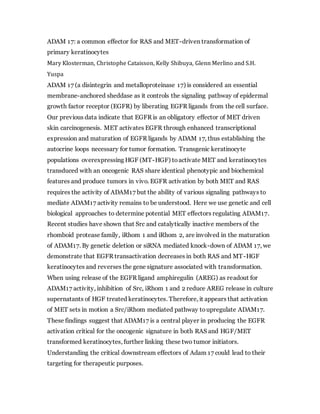CCR-FYIabstract (2)
•Download as DOCX, PDF•
0 likes•33 views
ADAM 17 is an enzyme that activates EGFR signaling by releasing EGFR ligands from the cell surface. Previous research showed that EGFR activation is required for skin tumor formation driven by the MET oncogene. This study found that ADAM 17 is necessary for EGFR activation by both MET and RAS oncogenes in keratinocytes. The researchers determined that MET activates a Src/iRhom pathway to upregulate ADAM 17 expression. Inhibition of Src, iRhom1 or iRhom2 reduced ADAM 17 activity in keratinocytes treated with HGF, linking MET to ADAM 17 through this pathway. Therefore, ADAM 17 appears to be a central player in producing the EGFR
Report
Share
Report
Share

Recommended
More Related Content
What's hot
What's hot (20)
George Wang's Lab Research at the Martin Lab Yale University

George Wang's Lab Research at the Martin Lab Yale University
Variation in chromosome structure and number chapter 8

Variation in chromosome structure and number chapter 8
TGF Beta Pathway and Inositol Phosphate Pathway In Cell Signalling

TGF Beta Pathway and Inositol Phosphate Pathway In Cell Signalling
Similar to CCR-FYIabstract (2)
Similar to CCR-FYIabstract (2) (20)
Describe a growth factor signalling pathway highlighting components.pdf

Describe a growth factor signalling pathway highlighting components.pdf
2016 micro rna in control of gene expression an overview of nuclear functions

2016 micro rna in control of gene expression an overview of nuclear functions
Epidermal growth factor and its receptor tyrosine kinase

Epidermal growth factor and its receptor tyrosine kinase
Genetic retargeting of E3 ligases to enhance CAR T therapy

Genetic retargeting of E3 ligases to enhance CAR T therapy
CCR-FYIabstract (2)
- 1. ADAM 17: a common effector for RAS and MET-driven transformation of primary keratinocytes Mary Klosterman, Christophe Cataisson, Kelly Shibuya, Glenn Merlino and S.H. Yuspa ADAM 17 (a disintegrin and metalloproteinase 17) is considered an essential membrane-anchored sheddase as it controls the signaling pathway of epidermal growth factor receptor (EGFR) by liberating EGFR ligands from the cell surface. Our previous data indicate that EGFR is an obligatory effector of MET driven skin carcinogenesis. MET activates EGFR through enhanced transcriptional expression and maturation of EGFR ligands by ADAM 17, thus establishing the autocrine loops necessary for tumor formation. Transgenic keratinocyte populations overexpressing HGF (MT-HGF) toactivate MET and keratinocytes transduced with an oncogenic RAS share identical phenotypic and biochemical features and produce tumors in vivo. EGFR activation by both MET and RAS requires the activity of ADAM17 but the ability of various signaling pathways to mediate ADAM17 activity remains to be understood. Here we use genetic and cell biological approaches to determine potential MET effectors regulating ADAM17. Recent studies have shown that Src and catalytically inactive members of the rhomboid protease family, iRhom 1 and iRhom 2, are involved in the maturation of ADAM17. By genetic deletion or siRNA mediated knock-down of ADAM 17, we demonstrate that EGFR transactivation decreases in both RAS and MT-HGF keratinocytes and reverses the gene signature associated with transformation. When using release of the EGFR ligand amphiregulin (AREG) as readout for ADAM17 activity, inhibition of Src, iRhom 1 and 2 reduce AREG release in culture supernatants of HGF treated keratinocytes. Therefore, it appears that activation of MET sets in motion a Src/iRhom mediated pathway toupregulate ADAM17. These findings suggest that ADAM17 is a central player in producing the EGFR activation critical for the oncogenic signature in both RAS and HGF/MET transformed keratinocytes, further linking these two tumor initiators. Understanding the critical downstream effectors of Adam 17 could lead to their targeting for therapeutic purposes.